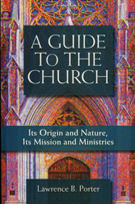
|
Posted February 13, 2008
Book: A Guide to the Church: Its Origin and Nature, Its Mission and Ministries Author: Lawrence B. Porter Alba House. N.Y. 2007. Pp. 442 An Excerpt from the Jacket:
An Excerpt from the Book: A Biblical Image of the Church: Jesus’ Sheep with Shepherd This chapter is given over to our consideration of one particular image of the Church, an image of the Church that has its origin in the preaching and teaching of Jesus himself. The image I refer to is that of “Sheep with Shepherd.” My choice of this image needs little defense. I chose this image for two reasons, both because of its indisputable historical importance and its current problematic status. “Sheep with Shepherd” is possibly the most abundant image of the Church in the New Testament. It is found not only in all four Gospels but also in Acts, several of the Pauline epistles, Hebrews, 1 Peter and the Book of Revelation. Moreover, from the beginning of the Christian movement this image of sheep with shepherd has shaped the very character of the Church, the Christian assembly, as not merely a casual and amorphous gathering of people, a crowd, but an organized indeed strategic and disciplined assembly (the strategic character of the Christian assembly will be treated in the section on mission). And thus it is no aesthetic caprice or theatrical indulgence that long ago it became traditional for the principal pastoral leaders in the Catholic Church, bishops, to carry a shepherd’s staff as a symbol of their office. Moreover, in almost all Christian assemblies today we can observe the distinction between “pastor” and “congregation,” English words that are derived from Latin and Greek originals meaning, shepherd and flock. But, despite its venerable antiquity, today, “Sheep with Shepherd” is a highly problematic image. This is due to its ability to both attract and repulse: attract some and repulse others. I cannot help but think most people are deeply offended at the suggestion that as followers of Christ they are a herd of dumb animals who must be led, even corralled. This reaction is especially so for members of modern democratic societies wherein general education has achieved a high level. On the other hand, I feel equally certain that even in modern democratic societies there is yet a small but appreciable number of Christians who find this image rather attractive. Some probably take a great deal of satisfaction and pleasure from this image because they see in it a precise depiction of their own talents and objectives, that is, they are convinced they themselves would make good leaders and they know precisely the direction in which the “flock” should be going. I hope to show that while there is some measure of truth in these two opposing reactions, both of these responses are little more than superficial reactions to the image of Sheep with Shepherd, reactions that can only be tempered by a deeper understanding of this image. . . .Sheep have a measure of intelligence: for example, sheep have a well-developed sense of weather; in bad weather they naturally seek shelter, and in hot weather they readily hunt for shade. Also they forage easily for themselves, that is, they recognize good pasturage and will readily go to it. And this should serve as a warning to pastors: while one sheep might occasionally get distracted and wander off, if many wander off it is probably a sign of poor pasturage — inane homilies, insipid music, indifferent liturgies. Table of Contents: Part 1: The Church: Its Origin and Nature 1. The church as a form of community 2. The church as sacred assembly 3. The origin of the church 4. The church and the kingdom of God 5. Models of the church 6. A biblical image of the church: Jesus’ sheep with shepherd 7. More biblical images of the church: people of God and Body of Christ 8. An image of the church from three North African theologians 9. Introduction to the essential attributes of the church 10. The unity of the church 11. The holiness of the church 12. The Church’s Catholic character 13. A church that is apostolic 14. The church is a communion Part II: The Church: Its Mission and Ministries 15. The mission of the church: its origin and content 16. The home mission: biblical portraits 17. The foreign mission: Paul’s inculturation of the gospel 18. The church and other religions 19. Church and state 20. Introduction to the concept of ministry 21. The ordering of Christian ministries 22. Promotion to ministry 23. Priestly ministry 24. Diaconal ministry 25. The Petrine ministry 26. The teaching ministry 27. Women and ministry 28. The ministry of a consecrated life |
|
